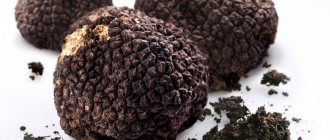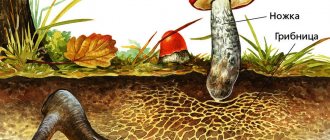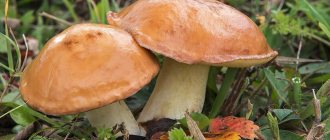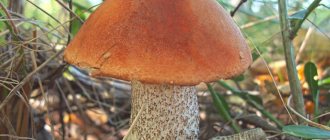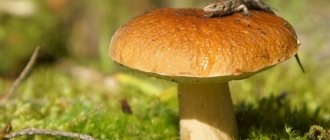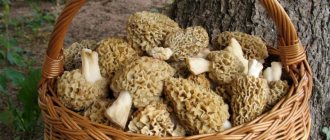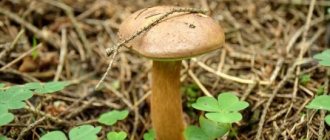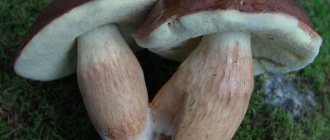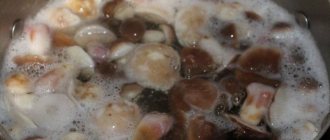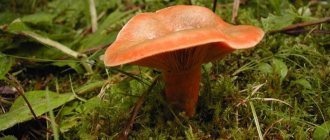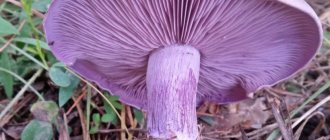Boletus mushrooms have an extremely slimy cap. You might think that this texture is not suitable for cooking, but they are actually eaten quite regularly. People who serve this edible mushroom must remove the top surface of the cap. This is done for two reasons: the texture of the mucus layer is not only unpleasant, but also contains toxins that cause gastrointestinal upset.
Edible boletus mushrooms: what do they look like, what can they be confused with?
Butterflies have several doubles, with which they can easily be confused. At the beginning of summer, that is, in the first days of July, you can find the first wave of butterflies hiding in pine forests. At the same time, false boletus and their doubles appear, which are very similar in appearance. But there are several differences between false and true boletus. There are several types of butter. That is why the mushroom can be seen at the beginning of summer and collected at the very end of autumn.
Differences between boletus and mushroom counterparts:
- False mushrooms have a purple film and a lamellar cap on the inside. A true mushroom has a thin film on the inside of the cap, which, when removed, reveals a porous structure; there are no plates there.
- At the cut site, false boletus secretes liquid, so after a while you will see yellowing. Such a mushroom should be immediately thrown out of the basket. False butterflies are not deadly mushrooms, but eating them can cause indigestion.
- In addition, they taste bitter and can spoil the main dish. Another doppelgänger of the oiler is the panther fly agaric. The difference between these mushrooms is that the poisonous counterpart has whitish spots. That is why the mushroom got its name. Reminds me of the color of a panther.
- But when you collect boletus, leaves or blades of grass may touch the cap. After removing the debris, light spots appear. Therefore, try to collect mushrooms that have no grass or leaves on top, and whose caps are clean.
Butter
Characteristic features of the species and rules for collecting boletus
In order to know what boletus looks like, you need to familiarize yourself with the features of the species and photos. The mushroom cap varies in structure and can be wavy or smooth, in the shape of a cone or hemisphere, which with age becomes more reminiscent of a pad. It can be brown or chocolate, depending on the light. Dimensions can reach 15 cm in diameter.
The hat is also covered with a special mucus that protects the mushroom from damage and bacteria. The presence of mucus clearly distinguishes oilers from other families. The spore-bearing layer is easily separated from the cap. The leg is full, smooth, granular. Sometimes you can find sections of the bedspread in the form of a ring. The pulp is white, with a yellowish tint; if the stem is cut, the color changes to red or blue. The spores are yellow.
Most often, boletus is distributed in the Northern Hemisphere, but in exceptional cases they can be found in Australia and African countries. Some species grow with only one type of tree, while others can live with various conifers - pine, larch, etc., but will feel comfortable only in well-lit forests. They can often be found in forest belts, coniferous thickets and forest clearings.
Mushrooms bear fruit from the beginning of summer until the end of autumn. The most optimal temperature for butter is +150C. The appearance can be expected immediately after rain. They do not like the cold very much and stop growing when the soil freezes to 3 cm. You need to collect oils very carefully so as not to damage the mycelium. Mushroom pickers use a special mushroom knife to cut off the stem as close to the ground as possible and immediately clean the mushroom of soil and debris.
Boletus mushrooms - edible: varieties, description, photo
Varieties of butter:
Leaf oiler. They have light gray or brownish flesh and a cap. The top is covered with a mucous coating. The leg has a characteristic ring, the flesh is porous, gray or white. Can be found in mixed forests in September and October.
Leaf oiler
The yellow-brown butterdish differs from the ordinary one in its color. The color is yellow, sometimes orange. If you break the cap, you will see the flesh of the same orange color. The stem has a characteristic ring. At the cut site it sometimes turns purple.
Yellow-brown oiler
Grainy boletus . Early species of mushrooms that can be found in coniferous forests in summer. The color is more faded than that of brown butterflies. At the same time, pores of different sizes are visible on the inside of the cap. Because of this, the oiler got its name.
Grainy boletus
Spring butter dish. It grows in young deciduous forests, as well as on sunny edges. Its surface is slightly sticky, the cap is yellow-brown in color. On the back of the cap there are pronounced pores that darken when pressed. This mushroom can be found in forests from early June to mid-September.
Spring boletus
White boletus has a light cap. In dry weather it is almost gray-white. After rain it turns olive. Mature mushrooms have a cap that is not dome-shaped, but almost flat. On mature mushrooms, gray or brown warts often appear in the cap area. When trying to remove the mucous membrane, it is easily removed.
White boletus
Grainy early oiler
The surface of the short stem of this oiler has grainy formations and no skirt, so it is not difficult to distinguish it from its peers.
The early mushroom is distinguished by its somewhat flattened cap and orange, brown and brick-colored skin. It is a frequent guest in foresters’ baskets, as it has a very pleasant taste.
Boletus mushrooms - false: varieties, what they look like, description, photo
False boletus is rare in our forests, but it’s worth being safe. They differ significantly from ordinary butter in their structure and color. Experienced mushroom pickers can easily distinguish such mushrooms.
Features of false butterflies:
- The fact is that in some literature, false boletus mushrooms are not classified as poisonous mushrooms, they are simply classified as inedible. This is due to the fact that the taste of such a mushroom is peculiar, quite bitter. In our latitudes we mainly find pepper butterflies , which are classified as false. But mushroom pickers don’t always throw them out of the basket.
- The mushroom is not poisonous, but its taste is very unpleasant, so experienced mushroom pickers first boil them to remove the bitter taste, and then fry them with everyone else. If you eat several of these butters, you are unlikely to get poisoned. But problems with the gastrointestinal tract may occur.
False boletus
Nutritional characteristics oily
Butterfly in general and butterfly in particular are one of the most popular forest mushrooms. They are suitable for use in any form - in soups, fried, stewed, salted, pickled, in sauces and side dishes. Young boletus is considered especially tasty when marinated or salted. Although boletus mushrooms can be dried for the winter, they are rarely used in this form, since they darken when dried.
Butter in any form of culinary processing goes well with fried potatoes and mashed potatoes, goes great as a side dish for meat and fish, and is also very good in various salads. Although it is not necessary to remove the sticky skin from the cap before cooking, the flavor profile does improve when it is removed.
In addition to excellent taste, boletus is also characterized by excellent nutritional value and health benefits. They are rich in B vitamins, contain a lot of fiber, carbohydrates, amino acids, fatty acids and essential oils. All substances contained in oilseeds are easily absorbed by the body, and the lecithin present in them even prevents the deposition of cholesterol.
However, it should be warned that boletus also contains a lot of chitin, and this substance cannot be absorbed by our body, and therefore it is still not worth abusing boletus.
How to distinguish false boletus mushrooms from real ones: comparison, similarities and differences
The difference between ordinary and false boletus is known to experienced mushroom pickers. Outwardly, it seems that the mushrooms are very similar, almost indistinguishable, but this is not so.
Differences and similarities of mushrooms:
- The surface of the false oiler is purple in color. If you turn the false mushroom over, you will see a grayish film. After removing it, you will see a plate-like cap. The edible mushroom has a white film, and underneath it lies porous pulp, that is, there are no plates.
- If you break the false oiler, a yellow spot will appear at the cut site after a while. Indeed, false boletus changes its color over time in places where there is a break. False butterflies also have a characteristic white ring. In true butterflies it has a purple tint.
Common boletus False boletus
Description
Butternuts are distinguished by the slimy surface of the cap, which makes them seem as if they are smeared with oil. This feature gave the mushroom its name. They are usually small and similar to flywheel mushrooms.
The oil can is real.
hat
When boletus just emerges from the ground, its cap has the shape of a rounded cone or hemisphere. As it grows, the cap straightens and becomes flat and cushion-shaped.
The mushrooms that have reached their largest size have a cap 15 cm in diameter. The color ranges from yellow to dark brown.
The cap is covered with a thin adhesive film. This is what creates the oily effect. The film can be removed quite easily by picking it up from the edge of the cap.
Ordinary oiler.
Leg
The stems of these mushrooms are not thick (reach 3 cm in diameter), light-colored, and can reach up to 10 cm in length. Sometimes the stem can be similar in color to the cap. Sometimes juice is released from the spore-bearing layer (hymenophore), which hardens on the stalk, giving its surface a rough appearance.
Spore-bearing layer
Hymenophore
or the spore layer of the oiler is represented by tubes. In young butterfish, they have a light yellow color, which over time transforms into brown. The mouths of the tubes, also called pores, are small and round.
Spore powder
The common oiler has a cover under the cap, which over time breaks with the formation of a small ring-shaped growth on the stem. The spore powder of this species is brown.
Pulp
White or cream. When cut, the pulp may remain the same color or change it (turn red, turn blue). However, it most often does not smell at all or smells slightly of pine. The flesh of the butter is quite dense, but at the same time very short-lived.
After just a week of growth, the mushroom becomes rotten. In addition, it is quite difficult to find boletus that is not affected by worms. By the way, most of the worms are found in the summer. In autumn, the proportion of pure mushrooms increases, as the activity of insects, whose larvae infect the mushroom pulp, decreases.
Mushrooms similar to boletus, edible and inedible: names, descriptions, photos
Butterflies do not have dangerous, poisonous counterparts. There are mushrooms that are conditionally suitable for consumption, but they do not cause severe poisoning and cannot cause death. Almost all boletus doubles can be eaten, but you just need to clean and boil them first, before subsequent heat treatment.
Doubles oil up:
- Kozlyak
- Siberian oiler
- Pepper oiler
All these species belong to conditionally edible mushrooms. Unrefined, they have a bitter taste and can cause intestinal upset. The taste of these mushrooms in their unpeeled form is unpleasant; it is bitter. Even with heat treatment, Siberian boletus does not lose its bitter taste. Therefore, despite the fact that they are not poisoned, they cannot be consumed due to their poor taste. The goat also looks like an oil can and is not a poisoned mushroom. But its taste is quite specific, which makes it difficult to use as food.
Kozlyak
Siberian boletus
Pepper butter
How to cook?
Cooking butter along with the peel
Butter gives cooks complete freedom in terms of cooking. Mushrooms can be baked, stewed, boiled, fried and added to soup. Also, some are convinced that they can be eaten raw. It takes about 15-20 minutes to prepare the butter. Their taste goes well with various spices and vegetables.
When it’s time to stock up for the winter, this mushroom also finds its use. It is pickled, salted, frozen and even dried. True, in the latter case, when all the moisture leaves the pulp, it becomes thin and brittle. However, this simplifies the grinding process, which produces mushroom powder that retains flavor and aroma. It makes an excellent seasoning for many dishes.
Before preparing the butterdish, you need to remove the skin from it and then rinse it under water. There is no need to keep mushrooms in liquid for too long, because... they quickly absorb it. After all dirt has been removed from the surface, you can begin cooking.
Where, in which forest and when to collect boletus mushrooms?
Mushrooms grow from June to October, and are most often found in large groups. At the beginning of fruiting and at the end, in 70% of cases, mushrooms are affected by larvae and worms. Therefore, they cannot be eaten. The optimal time for collecting boletus is September. At this time, it is best to come for mushrooms with buckets. A large amount of moisture stimulates the growth of mycelium. This mushroom is not solitary; if you find a separate mushroom, you should take a closer look around; most often, there are many more not far from this mushroom.
Regarding the places where butterweed grows, it is worth highlighting coniferous and mixed forests. They prefer to grow on edges, lawns, and along roads. Rarely found in swamps and wetlands, there is no point in collecting there. They are not often found in meadows, under isolated trees. It is in September that you can pick mushrooms for harvesting. They are quite dense, with porous flesh and are suitable for canning; they are rarely picked.
Mushrooms collected at the beginning of summer are not suitable for canning, because jars with such preparations swell. You cannot collect boletus from plantings that are located near industrial enterprises. Mushrooms absorb chemicals and heavy metals. Even edible mushrooms in this case can cause poisoning and disruption of the gastrointestinal tract.
Where do boletus grow?
Butterflies grow near coniferous trees.
Butterflies grow mainly in the northern hemisphere. Every year they can be observed in Russia, Europe, Asia and North America. They are also found in small numbers in Australia and Africa. They choose mainly coniferous forests, where there is a lot of light, as their habitat. They need the latter for normal growth.
Each type of butterweed appears near the roots of a specific tree. Mostly mushrooms are found near spruce, pine and cedar. But with rare exceptions, they are able to huddle near oak and birch trees.
Since the butterdish loves light, it often grows on the forest edge or along a path passing between trees. There, much less rays are blocked by foliage, so favorable conditions are created for germination. This also simplifies the collection of mushrooms, since a person does not need to go deep into the forest.
Interesting: Edible mushrooms - list, photo, name, description, video, when and where they grow
For the most part, boletus grows in small groups of 3-6 pieces. However, there are exceptions in nature. Some mushrooms of this species appear near the roots of trees in splendid isolation.
Is it necessary to clean the oil from the film?
Cleaning the film is a prerequisite when preparing butter.
The feasibility of cleaning oil from the film:
- The film is not poisonous or harmful, but during the process of frying unpeeled mushrooms, the film sticks to the pan and the mushroom falls apart. This spoils its appearance. If you are preparing soups, the film will give the dish a jelly-like state and a fairly viscous consistency.
- If you do not want to spoil the soup, the film must be removed. Before freezing, it is necessary to remove this film; after using the frozen mushroom, it will resemble jelly, and in general such mushrooms become watery and bitter when cooked.
- We recommend cleaning the film before freezing, frying, or boiling. Indeed, it is quite difficult to clean, so it is recommended to leave the mushrooms for a while so that the cap dries out. Then the film is easily removed with a knife.
- There is another cleaning option - boil it for a few minutes in boiling water. This way the film can also be easily removed.
Cleaning oily
Peculiarities
The mushroom is called butterfly because of its slimy cap. The film on top is easily removed. The hat has a convex or flat shape. It has a special smoothness. In an older mushroom it is slightly granular. Pulp with white, yellow tone. If broken, it may turn blue or red.
Butter has a lot of beneficial properties. The nutritional value is on par with porcini mushroom. They grow profusely. In some regions, “silent hunting” for these representatives is carried out from late spring to October. They are fried, stewed, boiled and pickled.
How to process boletus mushrooms?
To prevent the mushroom from becoming bitter and its aesthetic characteristics not to deteriorate, it is necessary to properly clean the oil from the film. This can be done with or without a knife.
Cleaning using a knife:
- It is necessary to lubricate your hands and hat with oil and leave for a few minutes. After this, pick up the film with a knife and carefully remove it. The oiled surface separates well from the cap.
- The boiling water method is also often used. You need to hold the butter over steam for a few minutes. Then the film is easily removed with a knife.
There are interesting and unusual ways without using a knife:
- Using gauze. This option is suitable if the butter is collected in humid weather, and the surface of the film is sticky and viscous. It is necessary to lay out the gauze on the table and press the cap tightly against it. Due to the fact that the surface will stick to a piece of fabric, you will be able to easily remove this film by simply picking it up with your nails.
- Another option for removing the film without a knife is to break the mushroom. It is necessary to break the mushroom in the center and in the place of the cap where the film will be located, simply move it in different directions. This way you can easily remove the film.
Cleaning the oil
How to prepare and what to cook
Before cooking, mushrooms must be carefully sorted, discarding unfamiliar or suspicious specimens. To clean the sticky caps from needles, leaves and particles of earth, pour cold water over the butternuts for a while, then rinse. Before cooking, it is advisable to pour the mushrooms again with salted water (for about three hours). This technique will allow you to get rid of all the insects and worms “lost” in the pulp.
To make boletus dishes tasty and safe, before cooking they must be well soaked in cold water and boiled until fully cooked. It is important not to mix representatives of different species. Nutritionists advise using finely chopped mushrooms for dishes - this way they are better absorbed by the body. Another easily digestible option is dried and ground into powder. In this form they are suitable for most dishes. It is recommended to store prepared boletus dishes in the refrigerator for no longer than 30 hours.
Any type of butter can be used to prepare boiled, stewed or fried dishes. But when choosing a cooking method, it is important to understand that heat treatment affects the concentration of nutrients in the product. When making supplies for the winter, in order to preserve maximum vitamins and minerals, it is better to dry mushrooms than to pickle them.
And one more piece of advice from experienced chefs. Butterflies of the first wave, that is, early ones, are suitable for preparing soups, stews and seasonings from dried mushrooms. But it is not advisable to pickle them. But mushrooms of the second and third waves are ideal for pickling and pickling.
And if early mushrooms are considered the most fragrant, then late autumn ones are the most nutritious and tasty.
“Semi-finished product” from boletus
For cooking you will need washed and peeled butternuts. Boil the mushrooms until tender with 1-2 onions, drain, chop into small slices and fry in oil with two raw chopped onions. Towards the end of cooking, add salt and other spices. Butter prepared in this way can be stored in the refrigerator as “raw material” for a future soup or stew, or added to stewed potatoes or meat.
Mushroom cutlets
Grind the boiled butter, add chopped onion (can also be ground), a little bread soaked in milk, and an egg. Season the minced meat with salt, pepper, and other spices as desired. Form cutlets from the prepared mixture, dip in breadcrumbs, and fry.
Butter with potatoes
Place a few pieces of butter and sliced raw onion in the bottom of an ovenproof dish. The second layer is boiled and then fried butter. The third layer is sauteed onions. The top layer is potatoes. Pour salted sour cream over everything, sprinkle with dill and bake in the oven.
Marinated mushrooms
There are several ways to marinate boletus. Some recipes suggest using only caps, others - using small young mushrooms. In any case, it is undesirable to mix old and young specimens in one jar.
Cook the peeled mushrooms (be sure to remove the film on the cap - it makes the mushrooms darken and get a bitter taste) with the onion. Place the prepared butter in a colander and, while the excess liquid drains, prepare the marinade. For it you will need 1.5 liters of water, 6 percent vinegar (150 ml), 1.5 tbsp. l. salt, 2 clove buds, 2 bay leaves. Place the mushrooms in jars, pour boiling marinade over them and sterilize before rolling (liter jars - 25 minutes, smaller ones - 15 minutes).
Are boletus mushrooms healthy: benefits and harms?
Butterflies are very healthy mushrooms due to the presence of nutrients in them.
Benefits of butter:
- They contain a substance that breaks down uric acid, which is very useful for migraines and gout. They contain a large number of various vitamins, which improves immunity and also prevents the occurrence of various infectious diseases.
- Boletus contains natural antibiotics that suppress the proliferation of pathogenic microflora in the body.
- These mushrooms contain protein, which in its composition is very close to meat protein. Therefore, it is advisable to eat mushrooms for vegetarians, as well as people who fast.
Despite the fact that boletus is very healthy, there are also several harmful properties:
- Mushrooms accumulate more than any other chemical elements, radioactive substances, and heavy metals. Therefore, you should not collect them near highways or near manufacturing plants.
- You should not eat this mushroom in large quantities. It contains chitin, which slows down the digestion of food and can cause indigestion. Therefore, consume the product in small portions.
The use of false oiler in cosmetology
Decoction and fresh mushrooms are often used to prepare face and hair masks. Beneficial properties help restore moisture and elasticity to the skin, and health and shine to the hair. There are quite a few recipes posted on the Internet that have positive reviews among the fair sex, who have tried out the usefulness of the mushroom product.
Can there be poisoning from boletus mushrooms?
Despite the fact that boletus is a very tasty, healthy mushroom, cases of poisoning have been recorded.
Causes of oil poisoning:
- The mushrooms were collected in places unsuitable for this. That is, along highways, or near chemical plants. In this regard, the mushrooms absorbed toxic substances and caused poisoning.
- Instead of ordinary butternuts, false ones were collected, which is why indigestion and disruption of the gastrointestinal tract are observed.
- The mushrooms were prepared without following culinary standards and were prepared in unsanitary conditions. Thus, E. coli or other pathogenic microorganisms could get into the dish.
Collected mushrooms
Contraindications
No matter how beneficial mushrooms are, there are always contraindications. Oil dishes contain chitin-impregnated fiber, which interferes with digestion in case of disturbances in the gastrointestinal tract.
Contraindications:
- individual intolerance;
- pregnancy or breastfeeding;
- acute gastrointestinal diseases;
- children under 7 years old.
All mushrooms accumulate harmful chemicals if they grow near an industrial plant or a rural area treated with herbicides. The radioactive substance cesium is also found in the body of mushrooms. Before cooking, the collected mushrooms are soaked several times and boiled at least twice, changing the water.
Why does the oiler turn blue when cut?
Many novice lovers of quiet hunting are frightened by the blue color that appears at the place where the mushroom is cut. Almost all mushrooms turn blue when cut, but in some it appears very slightly and almost imperceptibly, and mushrooms such as boletus turn blue quite strongly, a very dark violet-blue tint appears. There is no need to be alarmed, this is quite normal and does not affect the taste. The substances that make up oil oxidize in air, which is why it turns blue.
Another representative of mushrooms that turn blue at the point of cutting is goat mushroom. This mushroom is not poisonous; it is very similar to boletus, but has a bitter taste. Therefore, it can be collected in a basket along with other mushrooms. Before frying, it is necessary to boil so that the bitterness disappears. Therefore, if you find a blue tint where the mushroom is broken, you should not throw it out of the basket; it is an edible mushroom.
The oiler turns blue when cut
Butterflies are interesting, unusual mushrooms from which you can prepare a large number of tasty and nutritious dishes. They can be canned, fried, dried. Replenish your diet with butter.
Species diversity
All mushrooms of the Buttercup family have similar species features:
- The oiler is grainy, also known as summer or early. It has a thick fleshy cap and dense flesh with virtually no odor.
The thin tubular layer may secrete white droplets of sap and a stem with small brown scales. The main distinguishing feature is the absence of a ring on the stem. Prefers young plantings where there is a lot of light. Ripening period May – November. - Larch oil. It has a large cap up to 15 cm in diameter, the soft flesh turns slightly pink when broken, and has a pleasant mushroom smell. The leg is brownish in color with granular inclusions. Prefers to grow in deciduous areas and bears fruit from July to November.
Larch oil can - The oiler is yellow. Also called ordinary and autumn. The cap is yellow-brown, sometimes chocolate. The flesh is thick and milky in color, and the cylindrical leg always has a ring. Prefers pine habitat and is one of the most widespread species. Ripening period June – November.
Oiler yellow
In addition to the widespread Tubular species, there are many species that can be found in the forest and almost all of them have good taste and are recommended for consumption. Their types are distinguished according to the color of the cap and flesh:
- Grey.
- Bellini.
- Chestnut.
- Yellowish.
